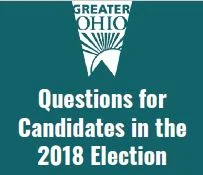The non-partisan Greater Ohio Policy Center (GOPC) released its “Questions for Candidates in the 2018 Election.” This document challenges the next governor, other statewide office-seekers, and legislative candidates to articulate their policy positions on a range of quality-of-life and redevelopment issues.
GOPC Sponsors Table at OARC Gubernatorial Forum; Cordray, DeWine Address GOPC’s Policy Priorities
Earlier this month, GOPC was a table sponsor at the Gubernatorial Forum hosted by the The Ohio Association of Regional Councils (OARC). Speaking to a roomful of the state’s top political, business, and civic leaders, Ohio Attorney General Mike DeWine and former Consumer Financial Protection Bureau Director Richard Cordray shared their campaign platforms related to transportation, infrastructure, job creation, and economic development.
Federal budget proposal would cut EPA funding and potentially change federal brownfields program funding
The White House released the proposed FY19 budget earlier this month, which intends to make cuts to several agencies and programs. The proposed budget would reduce the EPA’s budget by nearly 25%. The United States EPA currently oversees the brownfields program that administers state funding.
Greater Ohio Policy Center Unveils 2018 Public Policy Platform
15 Years of Preservation and Revitalization in Ohio
By Alison Goebel, GOPC Deputy DirectorEarlier this month, the Greater Ohio Policy Center joined more than 100 conservation, environmental, and urban advocates to celebrate the numerous successes of the Clean Ohio Fund. Since 2000, the Clean Ohio Fund has restored, protected, and connected Ohio’s natural and urban places by preserving open space and farmland, improving outdoor recreation, and cleaning up brownfields to encourage redevelopment and revitalize communities.
All 88 Ohio counties have received funding and benefited from the Clean Ohio Fund. The Fund has:
- Cleaned up nearly 400 abandoned, contaminated sites.
- Preserved over 26,000 acres of natural areas.
- Protected over 39,748 acres of family farms.
- Created over 216 miles of multi-purpose, recreational trails.
AsGreater Ohio Policy Center demonstrated in its 2013 study, the Clean Ohio Revitalization Fund which supported brownfield remediation, leveraged $4.67 in private dollars for every dollar invested by the state. More broadly, the entire Clean Ohio Program has leveraged additional investments to create a total economic impactof approximately $2.6 billion in public and private investments to date.
Governor Taft, whose administration initiated the ballot issue that created the Clean Ohio Fund, congratulated advocates and communities on the ongoing successes of the program. Former EPA Director, Chris Jones, and Kate Bartter, environmental policy advisor to Governor Taft, discussed the history of the ballot initiative and the thoughtful process that created this impactful program. House Minority Leader, Rep. Fred Strahorn, and Rep. Tim Derickson, a long time champion for Clean Ohio, described the impact of the program in their districts and around the state and the importance of the programs’ continuation.
The strong bi-partisan, multi-sector support for the Clean Ohio Fund, and clear economic benefits of the program confirms the value and importance of this program to Ohio’s economic development and quality of life strategies.






